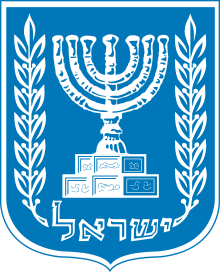Gush Emunim
| State of Israel |
|---|
 |
|
Gush Emunim (Hebrew: גּוּשׁ אֱמוּנִים , Bloc [of the] faithful) was an Israeli messianic,[1] right-wing activist[2] movement committed to establishing Jewish settlements in the West Bank, the Gaza Strip and the Golan Heights.[3] While not formally established as an organization until 1974 in the wake of the Yom Kippur War, Gush Emunim sprang out of the conquests of the Six-Day War in 1967, encouraging Jewish settlement of the land based on the belief that, according to the Torah, God gave it to the Jewish people.[4] While Gush Emunim no longer exists officially, vestiges of its influence remain in Israeli society.[5][6]
Political affiliations
Gush Emunim was closely associated with, and highly influential in, the National Religious Party (NRP). Nowadays they refer to themselves – and are referred to by the Israeli media as – Ne'emanei Eretz Yisrael נאמני ארץ ישראל (Hebrew: "Those who are loyal/faithful to the Land of Israel"). It also had a close relationship with the Jewish Agency.[7]
History
Gush Emunim was founded by students of Rabbi Tzvi Yehuda Kook in February 1974 in the living room of Haim Drukman,[8][9] who is also credited with coining the term.[10] In addition to Drukman, its ideological and political core consisted of other disciples such as Hanan Porat, Moshe Levinger, Shlomo Aviner, Menachem Froman, Eleazar Waldman, Yoel Ben-Nun and Yaacov Ariel.[11] Kook remained its leader until his death in 1982.
In late 1974, an affiliated group named Garin Elon Moreh, led by Rabbi Menachem Felix and Benjamin (Beni) Katzover, attempted to establish a settlement on the ruins of the Sebastia train station dating from the Ottoman period. After seven attempts and six removals from the site by the Israel Defense Forces, an agreement was reached according to which the Israeli government allowed 25 families to settle in the Kadum army camp southwest of Nablus/Shechem. The Sebastia agreement was a turning point that opened up the northern West Bank to Jewish settlement. The small mobile home site housing 25 families eventually became the municipality of Kedumim, one of the major settlements in the West Bank. The Sebastia model was subsequently copied in Beit El, Shavei Shomron, and other settlements.
In 1976, Gush Emunim founded the settlement-building arm Amana, which soon became independent and is still active.[5]
Ideology
The ideological outlook of Gush Emunim has been described as messianic, fundamentalist, theocratic and right-wing [5][12][13][14][15] Its beliefs were based heavily on the teachings of Rabbi Abraham Isaac Kook and his son, Rabbi Tzvi Yehuda Kook,[16] who taught that secular Zionists, through their conquests of Eretz Israel, had unwittingly brought about the beginning of the Messianic Age, which would culminate in the coming of the messiah, which Gush Emunim supporters believe can be hastened through Jewish settlement on land they believe God has allotted to the Jewish people as set forth in the Hebrew Bible. The organisation supported attempts to coexist with the Arab population, rejecting the population transfers proposed by Meir Kahane and his followers.[17]
See also
- Menachem Froman
- Israeli settlements
- Jewish fundamentalism
- Jewish Underground, a Jewish terrorist organization formed by prominent members of Gush Emunim
- Tzvi Yehuda Kook
- Moshe Levinger
- Moledet
- Orthodox Judaism
- Temple Mount and Eretz Yisrael Faithful Movement
- Terror Against Terror
Notes
- ↑ Ehud Sprinzak, 'From Messianic Pioneering to Vigilante Terrorism: The Case of the Gush Emunim Underground,' in David C. Rapoport(ed.),Inside Terrorist Organizations, Routledge 2013 pp.194-215, p.194.
- ↑ Peri Kedem, Amos Bilu and Zila Cohen (Lizer) "Dogmatism, Ideology, and Right-Wing Radical Activity" In Political Psychology, Vol. 8, No. 1 (Mar., 1987), pp. 35-47 JSTOR 3790985
- ↑ Fundamentalism, Terrorism, and Democracy: The Case of the Gush Emunim Underground by Ehud Sprinzak, Hebrew University of Jerusalem. Last accessed: 9 August 2009.
- ↑ Analyses of Gush Emunim have been carried out by David Newman. See: D. Newman, `Gush Emunim', Encyclopaedia Judaica Decennial Yearbook, 1994, pp. 171-172. Keter Publishers; D. Newman, `Gush Emunim: Between Fundamentalism and Pragmatism', Jerusalem Quarterly, 39, 33-43, 1986: D. Newman, `From “hitnachalut” to “hitnatkut”: The Impact of Gush Emunim and the Settlement Movement on Israeli Society’, Israel Studies, Vol 10 (3, 2005: See also T. Hermann & D Newman, `Extra Parliamentarism in Israel: A Comparative Study of Peace Now and Gush Emunim', Middle Eastern Studies, 28 (3), 509-530, 1992.
- 1 2 3 The Ideological Resonance of Zionist Fundamentalism in Israeli Society at the Wayback Machine (archived March 16, 2012), Katherine Allen, Behavioral Sociology of Identity Conflict, Spring 2005
- ↑ Encyclopaedia Judaica: Volume 8, p. 145
- ↑ Ian S. Lustick, For the land and the Lord: Jewish fundamentalism in Israel, chapter 3. 1988, the Council on Foreign Relations
- ↑ Ian Lustick, For the land and the Lord: Jewish fundamentalism in Israel, Council on Foreign Relations, 1988 p.63.
- ↑ Gershom Gorenberg, The Accidental Empire: Israel and the Birth of the Settlements, 1967-1977, Times Books, Henry Holt & Co., 2006 p.356.
- ↑ Gorenberg, The Accidental Empire, p.356.
- ↑ Lustick, For the land and the Lord,' p.73.
- ↑ Rebecca Joyce Frey, Fundamentalism, Infobase Publishing, 2009 pp.83ff., p.85.
- ↑ Motti Inbari, Jewish Fundamentalism and the Temple Mount: Who Will Build the Third Temple?, SUNY Press, 2012 pp.10ff.,p.21
- ↑ Carlo Aldrovandi, Apocalyptic Movements in Contemporary Politics: Christian and Jewish Zionism, , Palgrave Macmillan, 2014 pp.117-121, pp.117-118.
- ↑ Nur Masalha,The Bible and Zionism: Invented Traditions, Archaeology and Post-Colonialism in Palestine- Israel, Zed Books 2007 p.142.
- ↑ 'Eliezer Don-Yehiya, 'The Book and the Sword: the Nationalist Yehivot and Political radicalism in Israel,'in Martin E. Marty, R. Scott Appleby (eds.),Accounting for Fundamentalisms: The Dynamic Character of Movements, University of Chicago Press, 2004 pp.264-310 p.274.
- ↑ "Gush Emunim". Lexicon. Knesset. 2008.
External links
- For the Land and the Lord: Jewish Fundamentalism in Israel by Ian Lustick, 1988.
- Confessions of a Confused Religious Zionist
- Settling All the Land: The Birth and Growth of Gush Emunim by Rabbi Ed Snitkoff